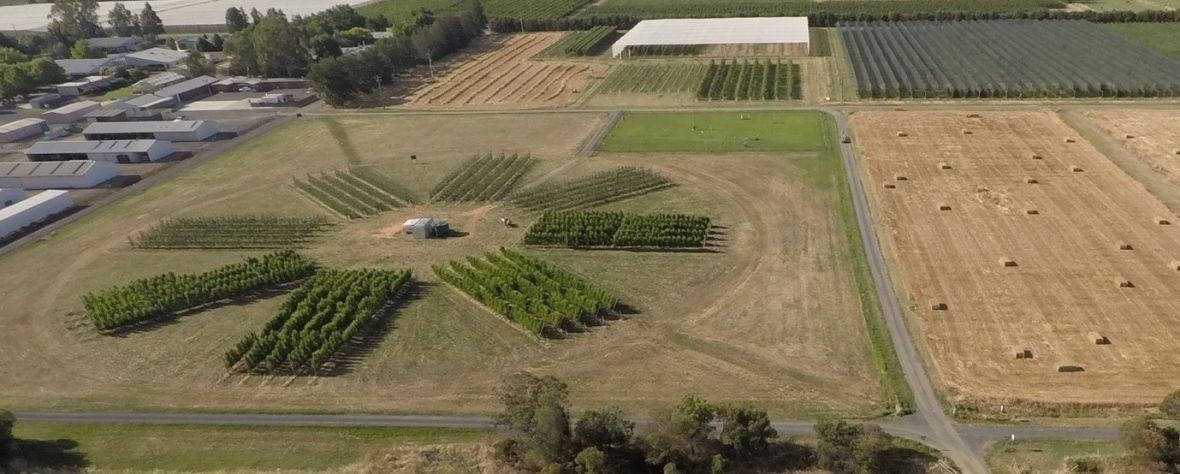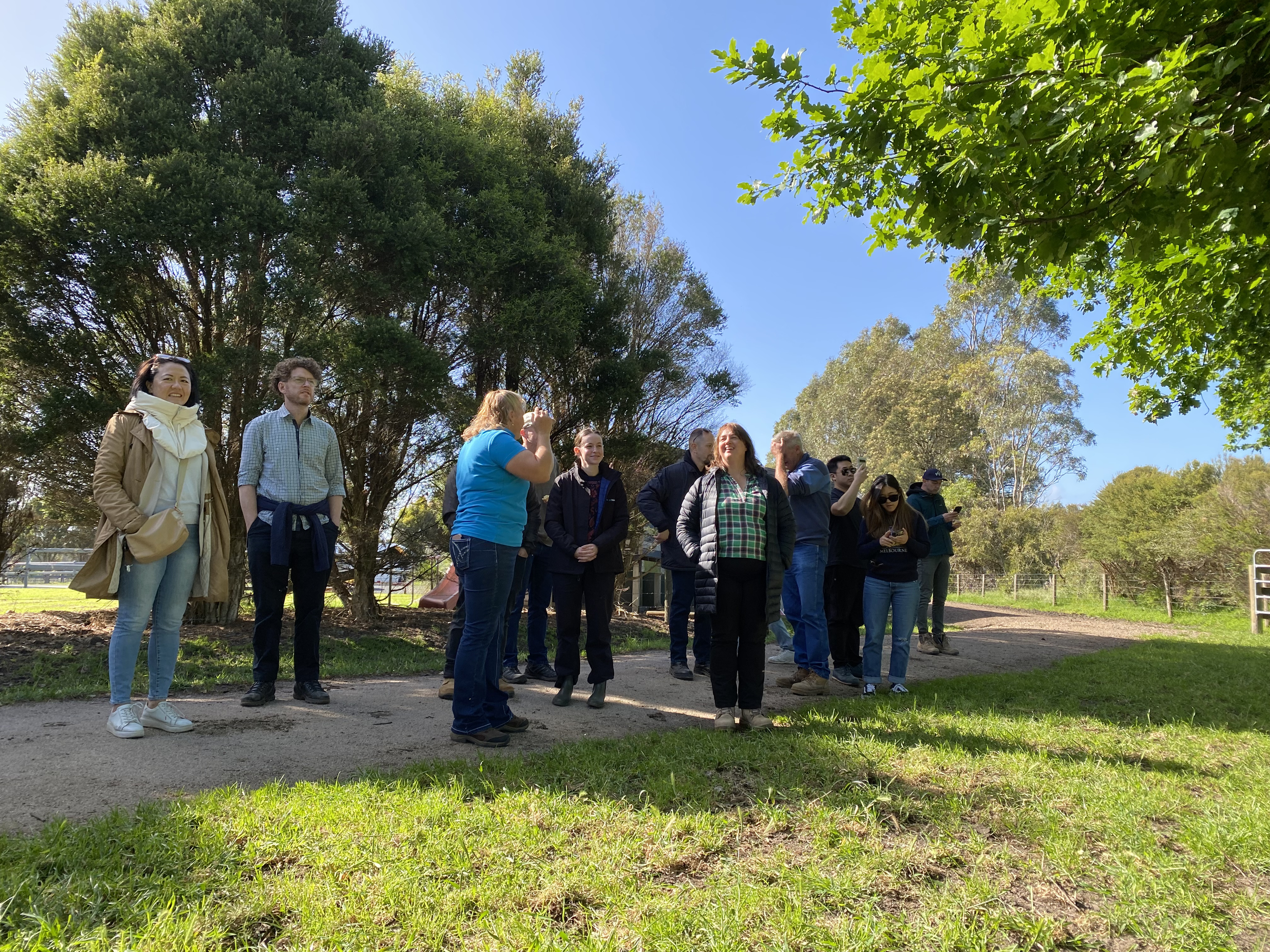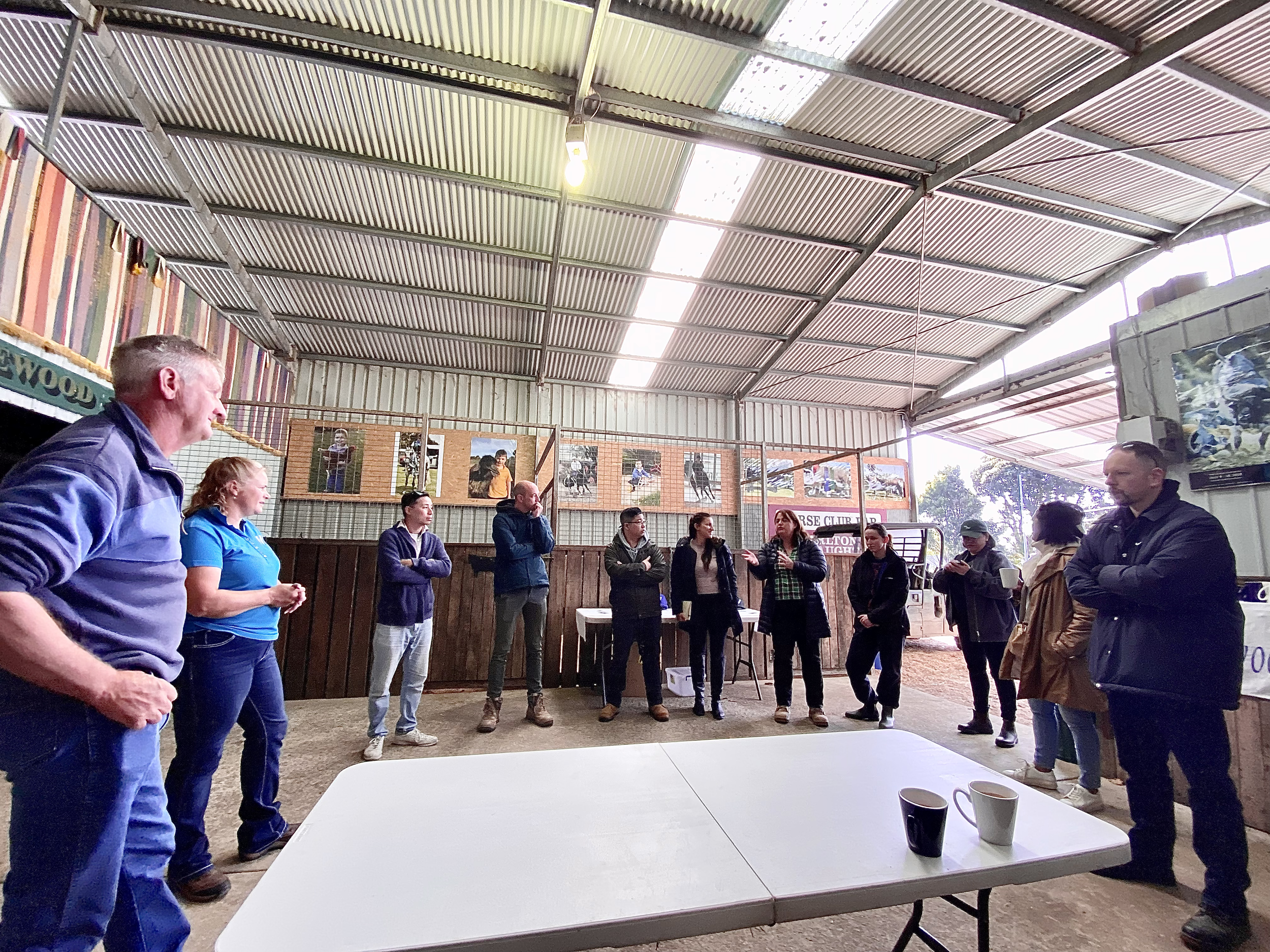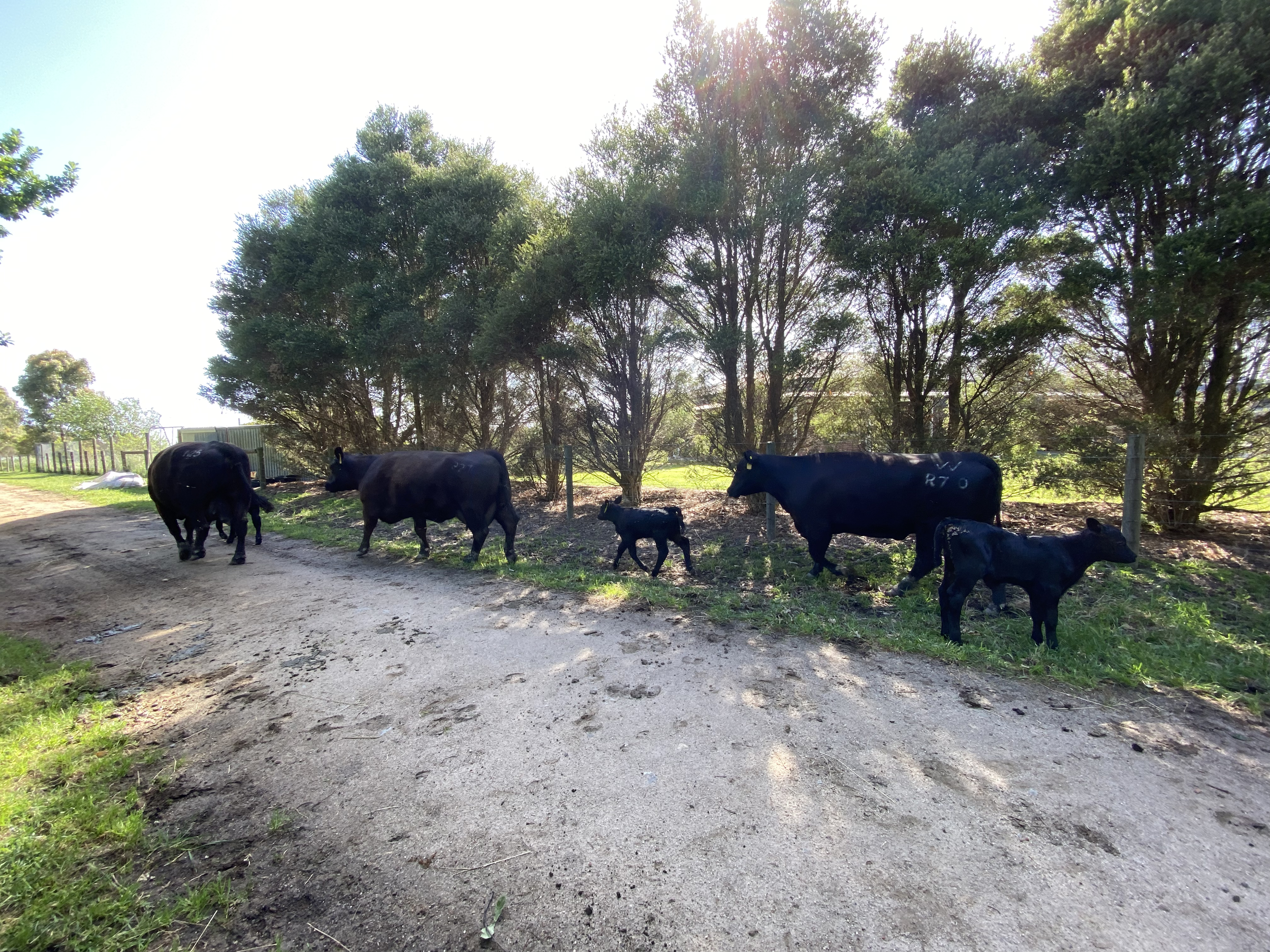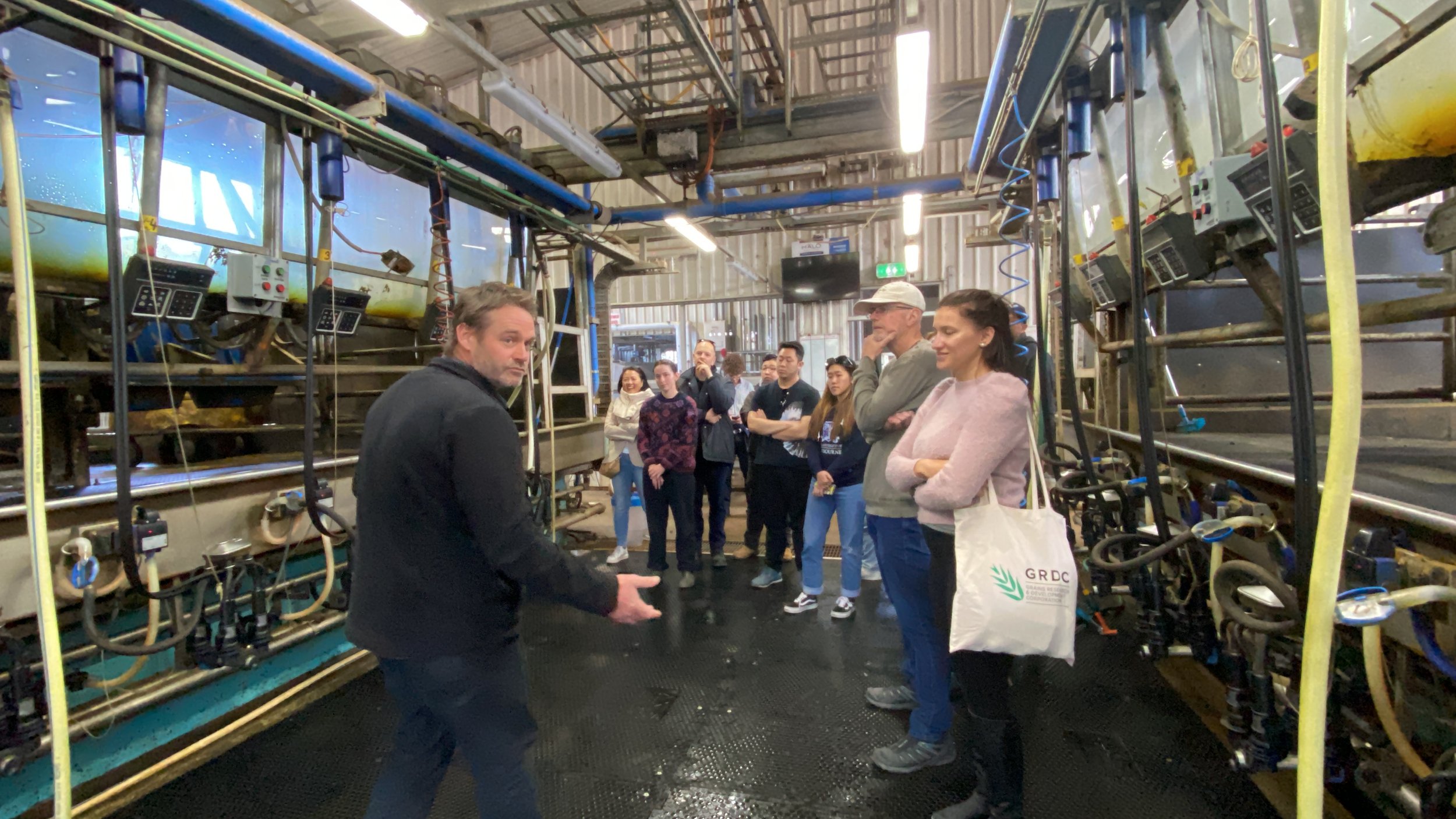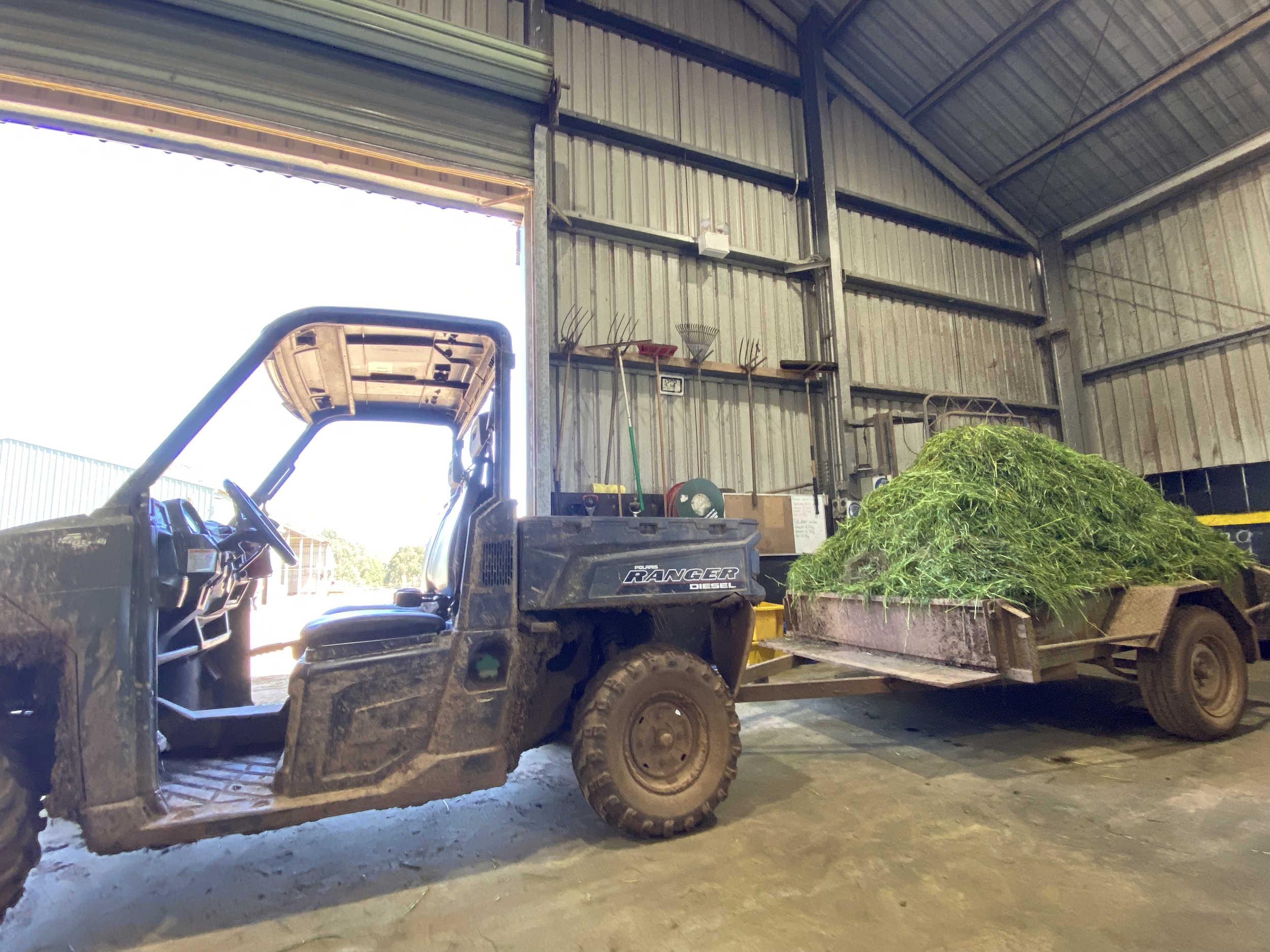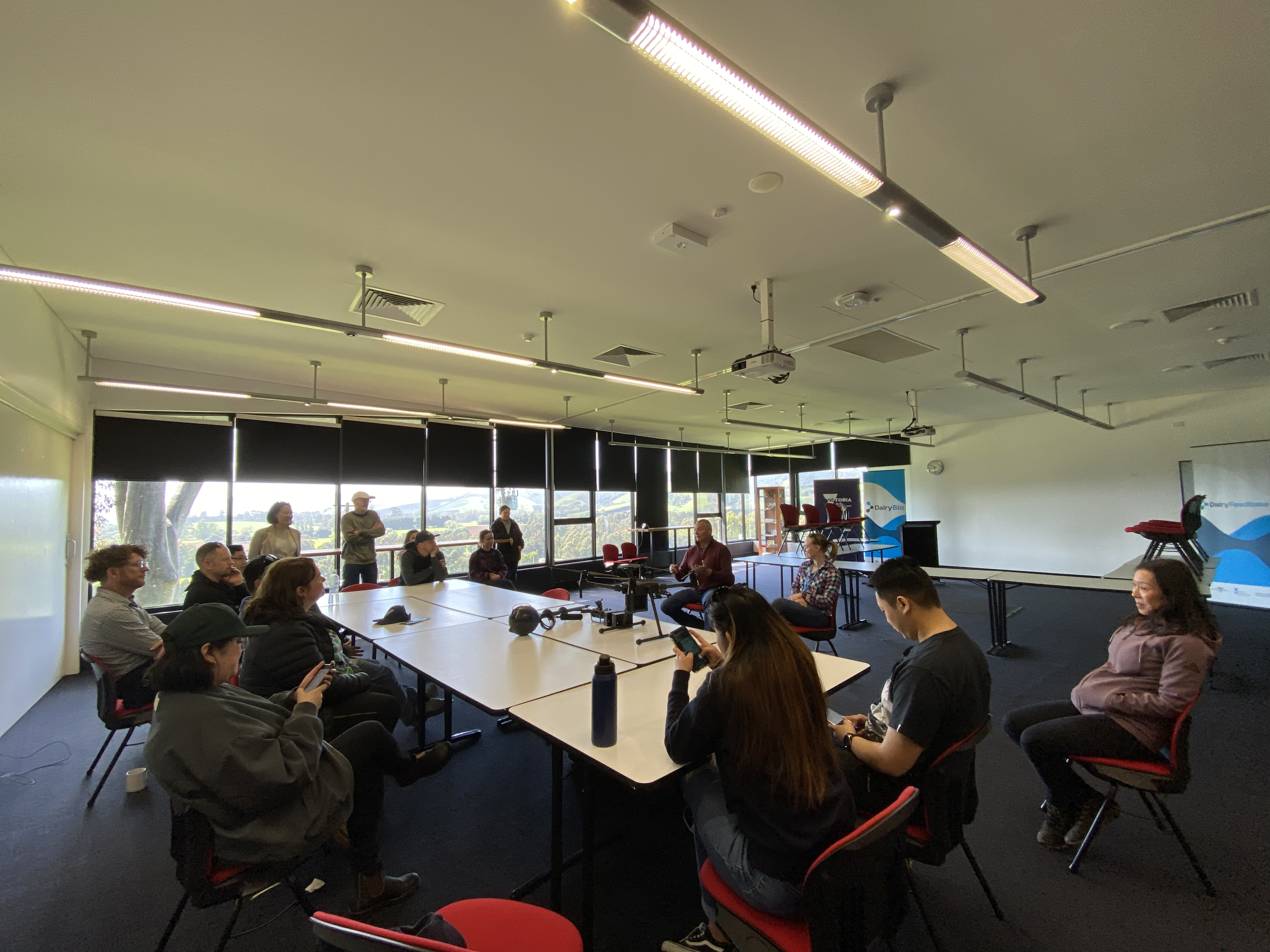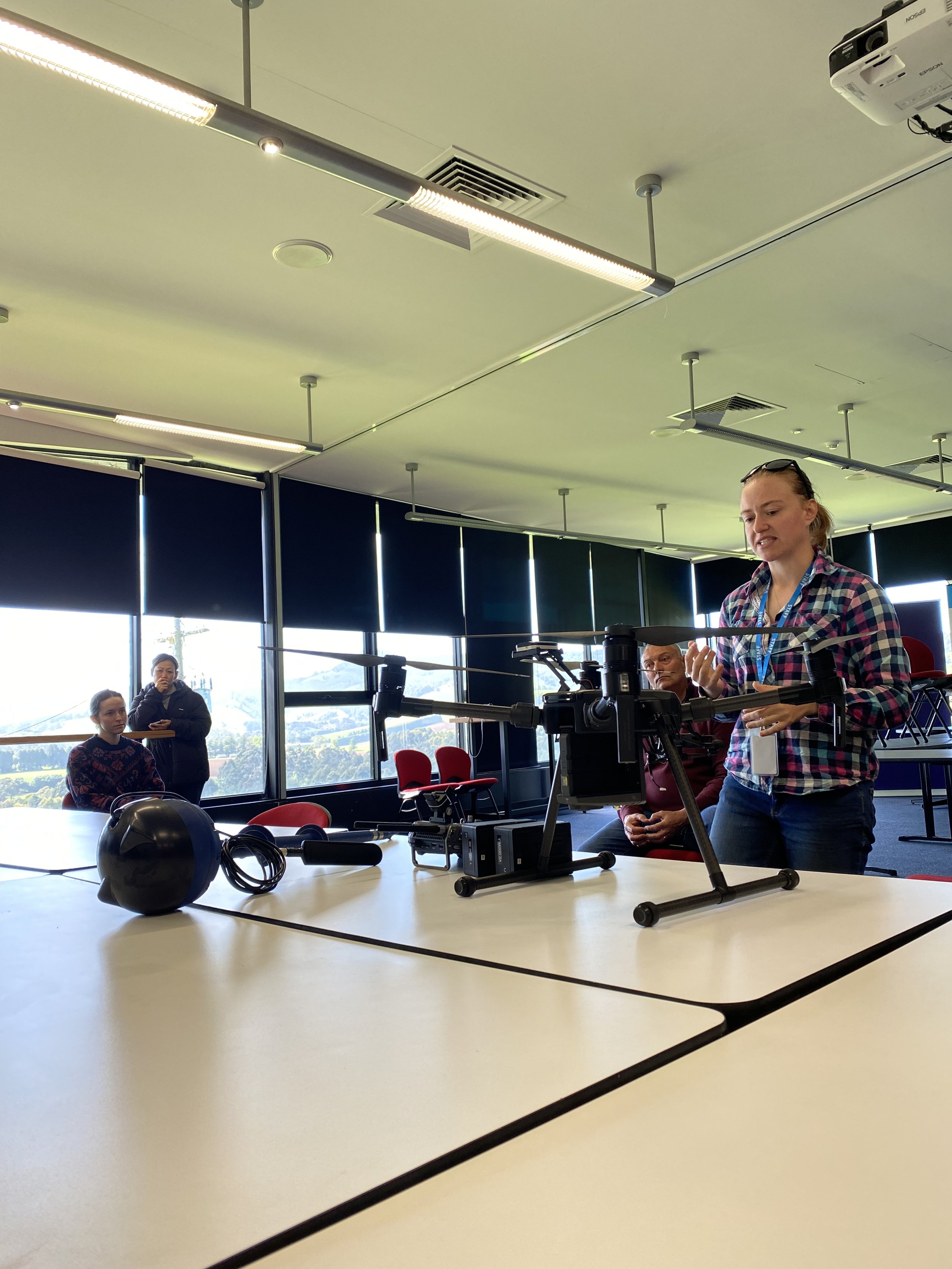Exploring AgTech Innovations at 5 Unique Farms
In October, the Spring 2023 cohort strapped on their boots for a road trip into regional Victoria to learn about the adoption of technology in agriculture. Our destination? Five exceptional farms, each with its own story of innovation and a commitment to reshaping traditional farming practices.
The producer tours unfolded over two days, with the generous hospitality from researchers and producers from Tatura SmartFarm, Plunkett Orchards, Wattlewood Farm, Ellinbank Smartfarm, and Wilandra Farm.
Armed with insights from our program, the cohort seized the opportunity to have their thought process challenged. By the end of day two, we made our way back to Melbourne, eyes closed from fatigue, but minds buzzing with fresh ideas from concrete outcomes – acquired new leads, confirmed assumptions of market size, and made crucial decisions to pivot or propel their ideas forward.
Special thanks to our invaluable partners and friends at Agriculture Victoria, LaunchVic, Tatura Smartfarm, Ellinbank Smartfarm, AUSVEG, Fruit Growers Victoria, Victorian Farmers Federation, Angus Australia, Dairy Australia, the team at Plunkett Orchards, Wattlewood Angus, and Wilandra Farms - for helping bring this enriching experience to fruition and their generous hospitality.
🍎 into the smartfarm of horticulture 🍐
Agriculture Victoria’s Tatura SmartFarm in Australia's Goulburn Valley is a leading research facility for horticulture. It is connected to the Mildura SmartFarm, allowing research and innovation to improve fruit quality and export. The focus is on developing and demonstrating agricultural technology for better yields and efficiency in pears, apples, stone fruit, and almonds.
Sundial Orchard: world’s first sundial multi-directional, experimental orchard
Advanced sensor technology and comprehensive approach to orchard design and training systems, particularly for stone fruit cultivation.
Ensuring traceability in the Sundial Orchard involves integrating productivity and extensive data into the API. Each tree throughout the entire orchard is equipped with individual tags for comprehensive monitoring.
Paired with the Experimental Pear and Stone fruit Orchards, this unique facility provides valuable insights into the relationship between orchard design and various factors, including production efficiencies, labor effectiveness, resilience to extreme climatic events, and the overall yield and quality of fruit. One of the key focuses lies in optimising sunlight capture and distribution within the canopy.
Improving precision and efficiency in orchard and fruit management involving:
Smart tracking of trees and fruit.
Data-driven smart irrigation scheduling.
Smart orchard connectivity through WIFI, LoRaWAN and 4G.
Headline indicators of Tatura’s research includes:
10% increase in marketable yield per hectare
20% increase in product value
20% increase in production efficiency
Fruit Analytics Facility:
In the Fruit Analytics Facility, a cutting-edge fruit phenomics platform assesses individual fruits from experimental orchards for key quality attributes like color, size, and maturity. This facility employs controlled environments to simulate variable conditions, contributing to enhanced insights into post-harvest fruit management.
Post-harvest practices involve maintaining a controlled atmosphere around the fruit, lowering temperatures to prolong shelf life. Dynamic monitoring, facilitated by sensors, ensures optimal oxygen levels, preventing issues like scald and surface oxidation that can occur as fruit ages.
Agrivoltiacs & the Horticulture Solar Energy Project:
Investigating the potential to improve fruit quality by protecting the trees and fruit from extreme heat events and sunburn as part of Victoria’s Agriculture Energy Investment Plan (AEIP).
The energy generated from the panels will be stored in a battery to drive the irrigation pump, solenoid valves and a fertiliser injector for the orchard block with excess energy fed into the grid.
Impact of the panels on tree growth, fruit yield, fruit colour and water use efficiency will also be measured.
Almond Excellence: The farm showcases innovative practices in almond production, demonstrating a commitment to efficient and sustainable methods.
Moisture levels in almonds are a critical factor influencing their quality.
A trial conducted at Mildura, facilitated by Ag Vic in collaboration with Harveston Aeration Solutions, focuses on adapting grain industry techniques to manage moisture levels in almonds.
The trial involves a setup similar to a grain bunker, adapted for almonds. A short silo allows air to pass through, utilising the natural humidity in the air to dry the almonds.
Collaborations with Startups and Universities: Throughout our visit, evidence of collabs with startups and universities emerged, highlighting the integration of research trials and smart orchard connectivity. Notable instances include:
The utilisation of the Tree2Me app for tree tracking and agility.
A partnership with Ruben's, a startup, showcased innovative technology leveraging fluorescents and specialised equipment for fruit tech development.
Additionally, the founder of Green Atlas, introduced a technology employing high-resolution cameras, strobe lights, hard discs, and GPS for advanced scanning capabilities.
“I didn’t know about the Smart Farms project prior to the tour with SproutX, this is such a great resource that more producers should have access to.”
🚜 out of the orchard inTO THE PACKING SHED 💨
Our journey then led us to Plunkett Orchards, a family-owned enterprise specialising in the cultivation of apples and pears, distributing their produce across Australia and beyond. In their pursuit of innovation, the owners ventured to Europe to explore cutting-edge agricultural technology. Inspired by what they discovered, they brought these practices back to Australia.
The orchard is located in the Goulburn Valley, Australia’s premier fruit-growing zone. Plunkett Orchards produces apples, pears, apricots and peaches across approximately 580 acres (235 ha) of orchards. The fruits grown at Plunkett Orchards are a mix of traditional and new varieties that are picked between November and May each year.
The facility is equipped with precision fruit grading technology that can sort fruits based on quality, size, and classification.
The packing shed is equipped with a state-of-the-art controlled atmosphere facility, boasting a substantial capacity of 16,000 bins (8,000 tonnes). During the off-picking season, all the fruit in the warehouse originates from the cold storage room. Surprisingly, the fruit available in supermarkets might have spent an average of 9-12 months in fridge storage before reaching your shopping basket! 😯
Innovative identification solution employing laser technology and light spectrum measurement to detect issues like bruising, discolouration, and bumps on fruit. Each fruit undergoes rapid on-conveyor belt rotation, with over 40 photos captured in an instant.
Peeked at the orchard’s unique hybrid apple varieties with - the "Candy" - a crossbreed featuring characteristics of the popular Pink Lady variety as one of the most popular variety.
The sorting facility handles around 36 drops in terms of packing line efficiency.
Tight quality-juice ratio to ensure a premium product. This means that the % level of juicing apples (apples that are sent to be juiced as they are not fit to sell on market shelves) is low within any harvest.
These insights offer a glimpse into Plunkett Orchards' commitment to innovation, quality control, the seamless integration of technology into their orchard operations and a solid team to ensure smooth operations.
🐮 breeding, genealogy, and home made calf herding carts 🤠
Wattlewood Angus specialises in advanced breeding practices in Angus cattle, particularly artificial insemination (AI) and estimated breeding values (EBV).
John Glover and his genius home-made calf capture tractor add-on.
Little cheat sheet on terminology
Stud (aka bulls): is a registered animal reserved for breeding. The terms for the male of a given animal species (stallion, bull, rooster, etc.) usually imply that the animal is intact - that is, not castrated - and therefore capable of siring offspring. Bulls are not castrated because they have desired traits that producers want to use for breeding - this is where genealogy (tracking, documentation, certification etc) technology comes in handy.
Steer: is a castrated male bovine. Male bovines are castrated when they are young and before they develop the bull’s physical characteristics, according to USDA. Steers are less aggressive than bulls. Steers are normally raised for meat.
Cow: is a mature female bovine that has had at least one calf.
Heifer: is a young female cattle that have not yet borne calves. Heifers can be used for breeding, and they can also be raised for beef.
Calf: Both baby male and female cattle are referred to as calves. They’re called weaners once they’re weaned, and then yearlings once they’re a year or two old.
The technologies you can expect to see in the beef industry are those centred around taking the guesswork out of the complex processes that drive genetic improvement, increased production, parasite and disease resistance, fertility, resilience to climate stresses. Using these innovations, producers of livestock and poultry are able to:
Track desirable traits such as parasite and disease resistance and climate resilience at a herd level, via wearable and implantable animal tags and performance monitoring tools.
Calculate Estimated Breeding Values (EBVs) using data from herd-based management systems and remote surveillance.
Predict and influence next generation traits using genomics.
Identify the best times to inseminate by monitoring heat and ovulation.
Increase embryo fertilisation rates with improved equipment and storage for artificial insemination or embryo transfer.
Reduce mortality rates in hatchlings and livestock.
Random learning of the day: be clear when using the term A.I., because in this side of town, it refers to Artificial Insemination 🤭
🐮 research in dairy with ellinbank smartfarm 🤠
Ellinbank SmartFarm is a research institute nestled in the heart of Gippsland that is dedicated to advancing dairy farming through state-of-the-art technology and research. The SmartFarm is home to a herd of 450 cows and is led by the ambitious target of being the world’s first carbon-neutral grazing dairy farm through:
reducing methane emissions
generating electricity through a range of alternate options including solar, wind and bio-digestion
improved fertiliser and manure management practices with anaerobic digestion technology
Research projects being conducted are focusing on a range of improvements including:
Optimising homegrown feed to improve farm operating profit,
Better health and welfare of cows by reducing the negative impacts of extreme heat events,
Increased production performance of cows while reducing costs,
Sustainably increasing annual milk production through a better understanding of herd nutrition and pasture management.
Some of the cohort’s top of mind learnings were:
Dual-purpose farm combining commercial dairy with cutting-edge research.
Methane capture research and collaboration with commercial partners.
Utilisation of various technologies for pasture measurement and analysis.
Challenges and benefits of virtual fencing for livestock management.
Biomass calculations
🐮 farm of future and wind turbines 🤠
Wilandra Farm, our final destination, epitomises sustainable livestock practices. Committed to ethical and environmentally conscious farming, this farm sets a benchmark for the future of livestock management. Our visited provided a deep dive into the delicate equilibrium between technology, habitat protection, animal welfare, and ecological sustainability.
The site is set in Clydebank (East Gippsland), Victoria and farm consists of about 950 acres (380ha) with a herd of 350 British Friesian cattles milked year round.
It’s been incredible to follow along the renewable farm energy project on site. Beginning in early 2021, the owners started a major project around energy efficiency and renewable energy. It’s embedded with an automated energy management system to reduce the use of conventional power for the farm’s irrigation and dairy processes. At that stage, irrigation used about 71% of the total consumed power. In a full irrigation season, it’s expected that energy costs associated with irrigation will drop from approximately $80,000 to $100,000 per annum to around $15,000 😲
Wilandra Farms has certainly set a standard as to what farming for the future could look like, with the aim to make work easier for the farm operators, more comfy for the cattle, and to improve our levels of biodiversity, and quality of natural resources, whilst returning a profit.
Learn more about the Wilandra Smart Energy Project here.
The Producer & Industry Tours was an opportunity to deep dive into the evolving landscape of agriculture and perspectives of founders towards agtech adoption and on-farm decision making. The picturesque backdrop made for a realistic focus into all the contributing factors and effort into how food arrives onto our table, land conservation and care, over the fence community support, and DIY solutions as the OG entrepreneurs of this land.
Our founders returned with more than memories — they carry a harvest of insights, new connections, and a strengthened confidence in positively affecting and contributing to the agricultural innovation from their own areas of expertise.
If you would like to join along insightful tours like this one or see what's on in the agtech space, join our AgTech Meetup Community today to be notified of our upcoming events.
🔧 tech wishlist 📝
Re-purposing waste collected during the produce sorting process
Advancements in virtual fencing for livestock management
Improved connectivity between different tech solutions on the farm
Development of methane detection sensors for emission control
Improved GPS Cow Monitoring
Traceability solutions for organic feed
Improved water monitoring devices on water troughs
💬 If you are an agtech startup with a solution for the above, get in touch with Petina at petina.watkins@sproutx.com.au (click through link) .
Join us at our upcoming Demo Day at Brunswick, Victoria to meet our industry partners and friends in person! RSVP to secure your seat here.

